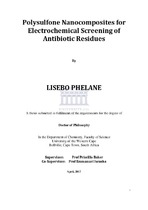| dc.contributor.advisor | Baker, Priscilla | |
| dc.contributor.advisor | Iwuoha, Emmanuel | |
| dc.contributor.author | Phelane, Lisebo | |
| dc.date.accessioned | 2018-07-31T12:40:17Z | |
| dc.date.available | 2018-07-31T12:40:17Z | |
| dc.date.issued | 2017 | |
| dc.identifier.uri | http://hdl.handle.net/11394/6134 | |
| dc.description | Philosophiae Doctor - PhD (Chemistry) | |
| dc.description.abstract | Antibiotics are defined as any class of organic molecule that kills or inhibits microbes by
specific interactions with bacterial targets. Antibiotics may be classified based on bacterial
spectrum (broad versus narrow), route of administration, type of activity (bactericidal versus
bacteriostatic), and origin (natural versus synthesized), and can also be classified based on
their chemical structure. The intensive use of antibiotics for human (domestic and hospital
use), veterinary and agriculture purposes, these compounds are continuously released into the
environment from anthropogenic sources, such as wastewater treatment plants which are
considered as one of the major source of evolution and spreading of antibiotic resistance into
the environment. | |
| dc.language.iso | en | |
| dc.publisher | University of the Western Cape | |
| dc.title | Polysulfone nanocomposites for electrochemical screening of antibiotic residues | |
| dc.rights.holder | University of the Western Cape | |

